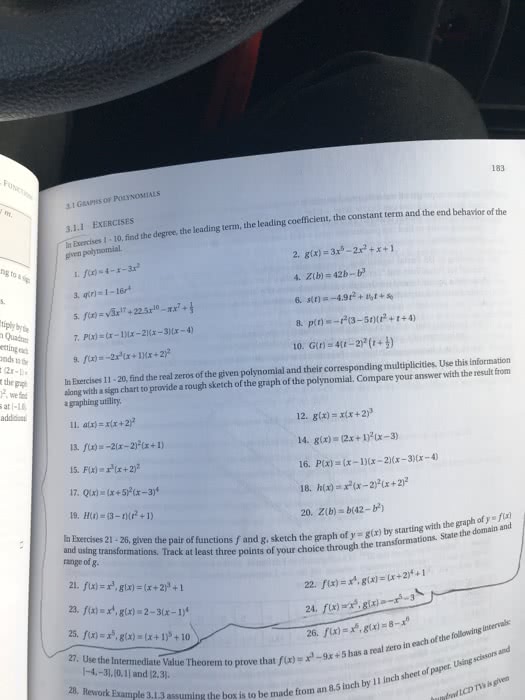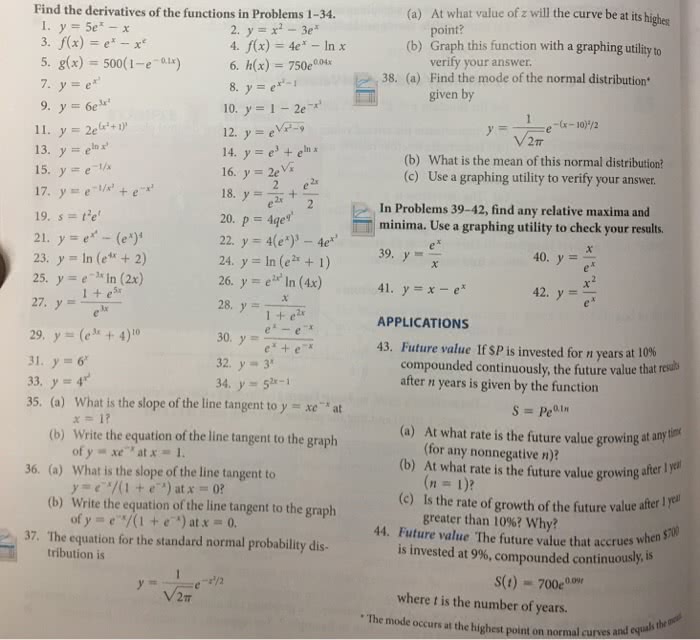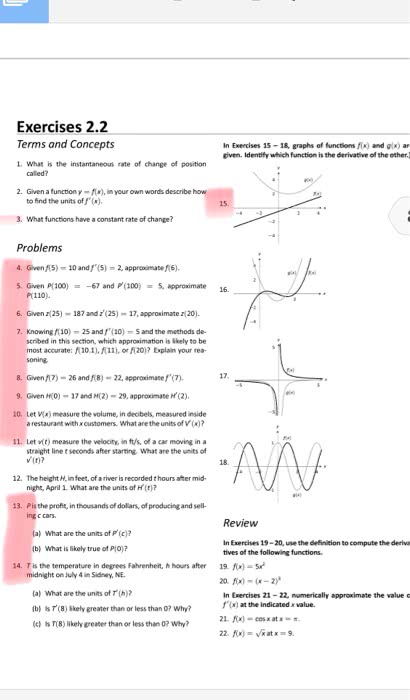MATH 151 Midterm: MATH 151 TAMU Y2015 2015c X2H Solutions

Fall 2015 Math 151
Exam 2H Solutions
Wed, 04/Nov c
2015 Art Belmonte
1. So f(x) = x
1+x2&f′(x) = 1−x2
(1+x2)2. The tangent is
y=f(3)+ f′(3)·(x−3) = 3
10 −2
25 (x−3) = 27
50 −2
25 x.
2. Now p=f g and q=f/gimply p′=f′g+f g′and
q′=g f ′−f g′
g2. Via table, p′(4) = 24 and q′(4) = 36
25 .
3. For t=20 (year 1920), backward and forward slopes
are 1750−1860
10−20 =11 and 2070−1860
20−10 =21; average slope:
11+21
2=16. Similarly, for 1980 average of slopes is
80+79
2=79.5. Rates are in millions of people per year.
4. Now s(t) = t3−6t2+9tand v(t) = 3t2−12t+9 or
v(t) = 3(t−1)(t−3).
(a) Velocity is 0 for t=1 or t=3, positive on
[0,1)∪(3,5], and negative on (1,3).
(b) In the first 5 seconds, the total distance traveled
is |s(1)−s(0)|+|s(3)−s(1)|+|s(5)−s(3)|
or 28 m. Or integrate speed: R5
0|v(t)|dt =28.
5. With y=2xsin x, we have y′=2sinx+2xcosx. At
x=π
2, the tangent line is y=π+2x−π
2or y=2x.
6. Recall f(x) = x/√1−cos2x.
(a) Graph at end shows jump discontinuity at x=0.
(b) As x→0−,f(x)→ −√2
2, but as x→0+,
f(x)→√2
2, verifying this jump discontinuity.
7. Now h(x) = f(g(x)), and h′(x) = f′(g(x))g′(x). So
h′(1) = f′(g(1))g′(1) = f′(2)g′(1) = (5)(6) = 30
via table. Similarly, k′(1) = 36 for k(x) = g(f(x)).
8. With f(x) = qx4−x+1
x4+x+1,f′(x) = 3x4−1
(x2+x+1)qx4−x+1
x4+x+1
=0
for x=±33/4
3=±1
4
√3≈ ±0.76.
9. Recall the hyperbola’s equation, x2−4xy +y2=4.
(a) When x=0, y=±2.
(b) Via implicit differentiation, y′=x−2y
2x−y.
At (0,±2), the tangent lines have slope 2.
10. [See page 2 for solution to #10 (hard).]
11. With position r(t) = −1
2t2,t, we have velocity
v(t) = [−t,1]and acceleration a(t) = [−1,0]. Thus
v(1) = [−1,1]and a(1) = [−1,0].Graph at end.
12. With position r(t) = [etcost,etsint], we have velocity
v(t) = [et(cost−sint),et(cost+sint)]. At t=0, the
velocity is [1,1]and speed is √2.
13. With x=3 costand y=−2 sint, the trig identity
cos2t+sin2t=1 implies x2
32+y2
22=1, an ellipse
traversed clockwise for increasing t.Graph at end.
14. The derivatives of f(x) = xexare (x+1)ex,(x+2)ex,
(x+3)ex,(x+4)ex... So f(n)(x) = (x+n)ex.
15. Now r(t) = [x(t),y(t)] = ecost,esinthas period 2π.
•Horizontal tangents: solve dy
dt =esintcost=0;
get t=π
2,3π
2∈[0,2π); note dx
dt =−ecostsint6=0
thereat; points (x,y)are (1,e)and 1,e−1.
•Vertical tangents: solve dx
dt =−ecostsint=0;
get t=0,π∈[0,2π); note dy
dt =esintcost6=0
thereat; points (x,y)are (e,1)and e−1,1.
16. Recall x=t3−3tand y=t2+t+1. The horizontal
tangent occurs when dy
dt =2t+1=0; i.e., at t=−1
2.
Note dx
dt =3t2−36=0 thereat. The lowest point is
(x,y) = 11
8,3
4= (1.375,0.75).
17. Volume of water is V=πr2h=25πh. Therefore,
dV
dt =25πdh
dt or dh
dt =dV /dt
25π=3
25π≈0.0382 m/min.
18. So cosθ=x
5gives −sinθ·dθ
dt =1
5
dx
dt &dθ
dt =−dx/dt
5sin θ.
At stated instant, x=3, y=4, hyp =5, dx
dt =1. Thus
dθ
dt =−1
5(4/5)=−1
4rad/s≈ −14.32◦/s.
19. Let xbe edge length of cube. Volume is V=x3and
surface area is S=6x2. Maximum error estimates in
Vand Sare dV =3x2dx =3(30)21
10 =270 cm3&
dS =12x dx =12 (30)1
10 =36 cm2, respectively.
20. Recall g(2) = −4 and g′(x) = x2+51/2for all x.
(a) L(x) = g(2) + g′(2)·(x−2) = −4+3(x−2).
(b) Now g′′ (x) = x
√x2+5. Quadratic approximation is
Q(x) = g(2) + g′(2)·(x−2) + 1
2g′′ (2)·(x−2)2or
Q(x) = −4+3(x−2) + 1
3(x−2)2.
21. At desired point, y-values and slopes are equal. Solve
x3−3x+4=3x2−xand 3x2−3=3(2x−1)to
obtain (x,y) = (2,6). Common tangent is y=9x−12.
22. [See page 2 for solution to #22 (hard).]
23. Solve y=f(x) = 2+√4+7xfor xto obtain
x=(y−2)2−4
7, whence f−1(x) = (x−2)2−4
7. See reverse.
24. With f(x) = x+ex,f(0) = 1. So g(1) = f−1(1) = 0
and g′(1) = 1
f′(g(1)) =1
f′(0)=1
(1+ex)|x=0=1
2.
1
Document Summary
1+x2 & f (x) = 1 x2: so f (x) = x (1+x2)2 . 10 2: now p = f g and q = f /g imply p = f g + f g and. Via table, p (4) = 24 and q (4) = 36. 25 . y = f (3) + f (3) (x 3) = 3 q = g f f g g2. 10 20 = 11 and 2070 1860: for t = 20 (year 1920), backward and forward slopes. Rates are in millions of people per year: now s (t) = t 3 6t 2 + 9t and v (t) = 3t 2 12t + 9 or. 80+79 v (t) = 3 (t 1) (t 3). (a) velocity is 0 for t = 1 or t = 3, positive on. 0 |v (t)| dt = 28: with y = 2x sin x, we have y = 2 sin x + 2x cos x.



